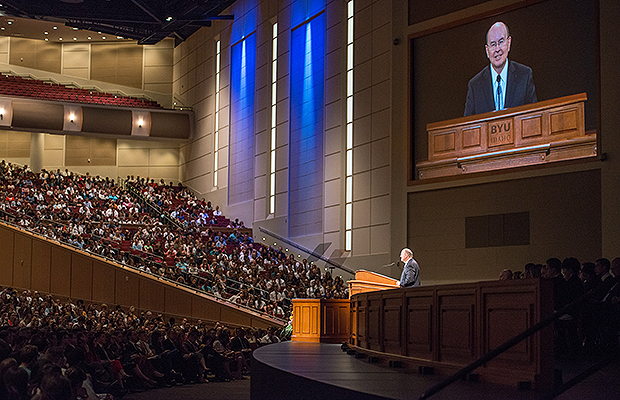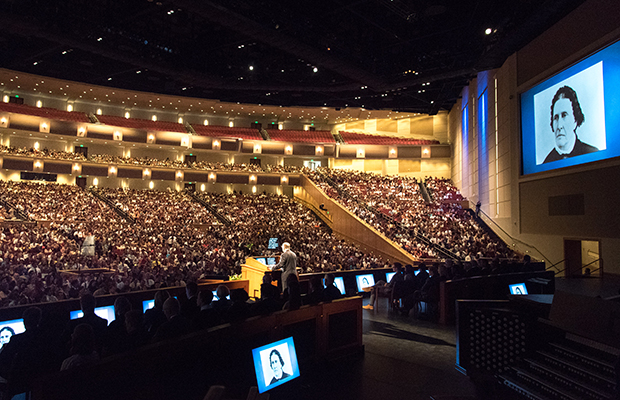Recent Projects Helping Church History Come “Out of Obscurity,” Says Elder Cook
Contributed By Sarah Jane Weaver, Church News editor

Elder Quentin L. Cook of the Quorum of the Twelve Apostles waves after a BYU–Idaho devotional on Tuesday, June 12, 2018. Photo by Cami Su, BYU–Idaho.
Article Highlights
- Recently, the Church has collected more records and shared more history than ever.
- Efforts such as the Joseph Smith Papers are bringing Church history “out of obscurity.”
“There may be some things that we will not understand fully in that history, but in totality, the true stories are beautiful and build faith in Jesus Christ and His restored gospel. They evidence how merciful the Lord has been.” —Elder Quentin L. Cook of the Quorum of the Twelve Apostles
Related Links
REXBURG, IDAHO
Church members can “plant faith by studying more about Church history, said Elder Quentin L. Cook of the Quorum of the Twelve Apostles during a BYU–Idaho devotional on Tuesday, June 12.
“In learning more, we will bind our hearts together with the Saints of yesterday and today,” said Elder Cook. “We will find examples of imperfect people who went forward with faith and allowed God to work through them to accomplish His work. In doing so we will see better how He can work through imperfect people like you and me.”
It is true, added Elder Cook, that some Church history has been misunderstood. “Much has been forgotten or overlooked, obscured and crowded out by the larger concerns of the world. Some people have even purposely misrepresented stories of the past to sow doubt.”
Addressing the topic “Out of Obscurity: How Merciful the Lord Has Been,” Elder Cook detailed what the Church is doing currently to collect, preserve, and share its history.
In a revelation recorded in Doctrine and Covenants 1:30, the Lord promised the Prophet Joseph that He would bring forth His Church “out of obscurity and out of darkness.”
Across many disciplines and fields of endeavor the Church has in dramatic ways become better known and more visible, explained Elder Cook before addressing Church history—an area where “growth, visibility, and quality have increased dramatically.”
Elder Cook said on the day the Church was organized, the Lord declared, “Behold, there shall be a record kept among you” (D&C 21:1).
“As Latter-day Saints, we have always been commanded to keep records documenting our own lives and the life of the Church. Soon after the Church’s organization, Joseph Smith also received divine guidance that he should appoint a Church historian.”
He asked Oliver Cowdery and then John Whitmer to take on the responsibility.
Joseph Smith received two revelations for John Whitmer that described some of the duties of the Church historian. He was asked to write and keep a regular history, obtaining things for the good of the Church and for the rising generations.
Since those early days, the Church “has been blessed by a long line of dedicated, faithful Church historians” who have made great efforts to preserve and share its history, particularly “to teach the rising generations about our past,” said Elder Cook.
In recent years Elder Steven E. Snow, a General Authority Seventy, has been the Church Historian and Recorder. “Under his wise leadership, we have collected more records than ever before and shared more of our history than ever before,” said Elder Cook. “These efforts are helping the history of the Church to come ‘out of obscurity.’”
Today, Church members know more about their past than ever before, said Elder Cook. The catalyst for much of this new knowledge has been the Joseph Smith Papers.
Founded in 2001, the project is publishing all of Joseph Smith’s documents—his letters, journals, revelations, histories, minutes of meetings he attended, and even business and legal records.
In the past, authors wrote on the history of Joseph Smith and the early Church without always using the extensive documentary record left by Joseph and other early Latter-day Saints, said Elder Cook. “Because of the Joseph Smith Papers, never again can authors write on Joseph and the early Church in a credible manner without accessing Joseph Smith’s own documents.”
An integral part of the Joseph Smith Papers Project is its website, josephsmithpapers.org, he added. “You can see what Joseph Smith’s documents say about topics such as priesthood restoration and the Nauvoo Relief Society. You can see the images of the actual documents, the handwriting of the Prophet and his associates in the work.”
There is power in being able to see historical documents, Elder Cook explained.
Students with FamilySearch accounts may have even received an email regarding the Joseph Smith Papers. On the Joseph Smith Papers website, there are currently 935 biographies of individuals who interacted with the Prophet in some way.
Elder Cook said the Church has benefited in numerous ways from the Joseph Smith Papers.

Elder Quentin L. Cook of the Quorum of the Twelve Apostles speaks during a BYU–Idaho devotional on Tuesday, June 12, 2018. Photo by Michael Lewis, BYU–Idaho.
In 2013, a new edition of the Doctrine and Covenants was published with about 80 updated section headings; the headings include new information on the historical context of the revelations from the Joseph Smith Papers.
Church members also have a more well-rounded view of the Prophet, his ministry, and his life because of the project, and more and more books, scholarly articles, and histories of the early Latter-day Saints are relying on the project’s publications, he said. “The Joseph Smith Papers emphatically demonstrate that the Prophet Joseph can withstand historical scrutiny!”
Because most Latter-day Saints will not read these 17 massive volumes of historical material, the Church uses the insights from the Joseph Smith Papers in other products, such as a series of articles called “Revelations in Context,” said Elder Cook.
In addition, in recent years, the Church has published a series of Gospel Topics essays that often draw upon new knowledge about our past to help increase understanding of subjects such as Book of Mormon translation, the book of Abraham, and plural marriage. “If you have questions about these topics, I encourage you to begin your study with these essays,” Elder Cook said.
The Church has also recently focused more on understanding and describing the experience of women throughout Latter-day Saint history, said Elder Cook.
In the past few years, the Church has published in print and online two large collections of women’s history, he said. The first is a compilation of the most important documents from the first 50 years of the Relief Society. The second, At the Pulpit, contains sermons by women from each decade of the Church’s history, from Lucy Mack Smith in 1831 to Sister Gladys Sitati in 2016.

Elder Quentin L. Cook of the Quorum of the Twelve Apostles speaks during a BYU–Idaho devotional on Tuesday, June 12, 2018. Photo by Cami Su, BYU–Idaho.
“These powerful discourses contain deep insights into the gospel of Jesus Christ and how we can better live our religion,” said Elder Cook.
The Church opened a new, state-of-the-art Church History Library in 2009. The library contains “a tremendous variety of materials,” said Elder Cook.
“The breadth of materials testifies to the Church’s ongoing efforts to spread the word of God across the earth in every possible way. The Church carefully preserves all of these records so that we can continue to learn from them.”
As the Church has grown, so too has greatly increased record keeping. A major focus in recent years has been acquiring more records about international history and women’s history, he said.
“These records are not just of interest to historians. They are used every day in carrying forward the work of salvation. Church leaders often seek to understand historical records to make decisions for the contemporary Church.
“Because most Church members cannot come to Salt Lake City to look at records, the Church is digitizing records so that more people have access to them. There are now more than 11 million images in the library’s online catalog. And more are put up at a rate of approximately 300 images per hour.”
Many records—including a pioneer database of 57,000 and a missionary database of 38,000—are also of interest to persons seeking information about their ancestors, said Elder Cook.
Elder Cook also spoke about a Church history project that is about to be published. For the first time in nearly a hundred years, a new multivolume history of the Church is being issued under the direction of the First Presidency and the Quorum of the Twelve Apostles.
Titled Saints: The Story of the Church of Jesus Christ in the Latter Days, this narrative history tells the true story of ordinary people who became Saints through the Atonement of Jesus Christ, said Elder Cook. The first volume, The Standard of Truth, 1815–1846, is now complete and is being translated into 14 languages for distribution all around the world.
Saints is the story of how God restored His everlasting covenant because of His love for His children. “It shows how the Lord restored His gospel to provide hope and peace in times of tumult, trial, and suffering. It also shows how restored covenants lead to exaltation through Jesus Christ. … Saints continues a divine pattern in which prophets as part of their ministry use the past to help us learn who we are and see God’s purposes in our lives.”
Concluding, Elder Cook said the history of the Restoration will continue to unfold. “There may be some things that we will not understand fully in that history, but in totality, the true stories are beautiful and build faith in Jesus Christ and His restored gospel. They evidence how merciful the Lord has been.”

Students leave the BYU–Idaho Center after a BYU–Idaho devotional on Tuesday, June 12, 2018. Photo by Michael Lewis, BYU–Idaho.
